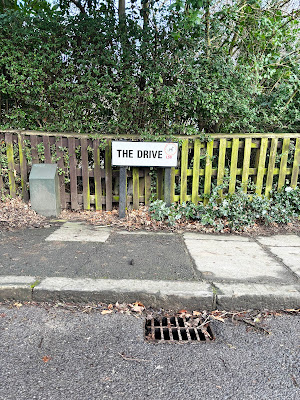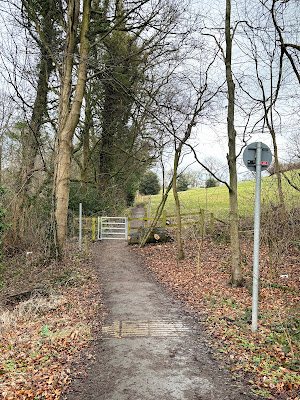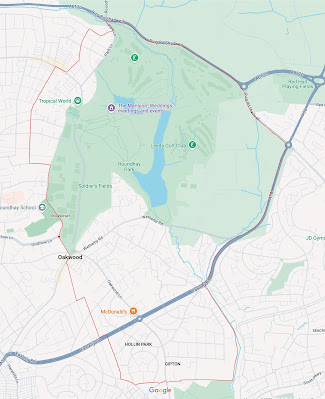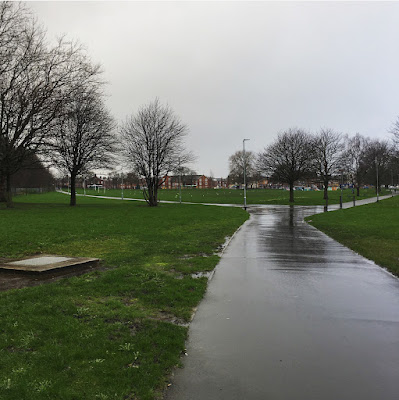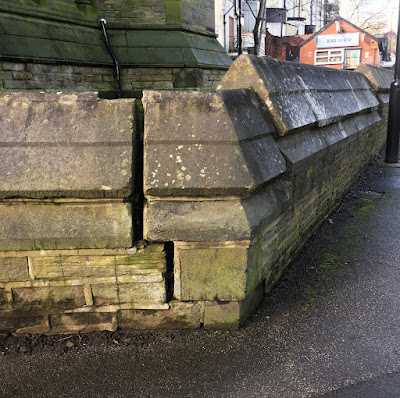33 Temple
A blog recording the work and activities of Patrick S. Ford
Wednesday, July 9, 2025
'One Step Forward, Two Steps Back' - 11 November 2023
Sunday, March 2, 2025
'Roundhay Walk' - Terminalia Festival 2025
For the Terminalia Festival this year I contemplated a walk back in my hometown of Leeds, in the north of the UK.
Roundhay Park is a large urban park within the city, covering over 700 acres, at around 3 miles north of the city centre.
The current extent of the park is the remaining section of an old hunting park, originally owned by the de Lacys, Lords of Bowland. Eventually sold to Thomas Nicholson and Samuel Elam, the northern part of the estate was taken by Nicholson and passed down through the family until being put up for sale in 1871. The rest of the old estate was sold off in sections for building development.
It was my plan to walk close to the original boundary of the estate, making slight detours where necessary to avoid private land and other contemporary obstacles. As a guide, I am using the 1847 ordnance survey six-inch map, which seemed a fair approximation of the area and a convenient line to follow.
Monday, February 17, 2025
'No holiday', Danes Dyke, East Yorkshire, UK - 18th March 2022
After another push to update neglected write-ups and posts, I secured enough time to sit down and edit the footage taken of the 'No holiday' performance that was enacted at Danes Dyke in the East Riding of Yorkshire, UK on 18 March 2022.
The ambulatory performance began at the entrance to the Danes Dyke public park area on Flamborough Road, B1255. The access road for cars runs along the dyke to the car park which is situated on the flat area where Danes Dyke House once stood. Built in 1873 for Elizabeth Cotterell-Dormer, it was later demolished in 1953, though some relics still linger, such as the Monkey Puzzle Tree - a species imported to the Uk from South America.
Despite the Dyke's name, it is now thought that the dyke is prehistoric in origin. In the past, sections of the dyke have been used as settings for filmed reconstructions of Viking attacks.
Danes Dyke is a leisurely walk from Sewerby Hall, along the cliff-top path. This footpath continues along the cliffs, passing through South Landing and on to Flamborough Head.
This is a lovely part of the country and well worth a visit.
Tuesday, January 21, 2025
Terminalia 2025 Roundhay Walk - Planning
As the Terminalia festival approaches once again I began to consider another walk. On 23rd February each year a one day festival of Psychogeography is held across the UK and the world, entitled 'Terminalia'.
As the festival website states, it is 'a one day festival of walking, space, place and psychogeography' named after 'Terminalia...the festival of Terminus, Roman god of boundaries'.
Many events are group walks and encourage participation but there are also 'private, solitary walks' that are also listed on the main festival website.
This year I contemplated a walk in my hometown of Leeds, in the north of the UK.
Roundhay Park is a large urban park covering over 700 acres, around 3 miles north of the city centre.
The current extent of the park is the remaining section of an old hunting park, originally owned by the de Lacys, Lords of Bowland. Eventually sold to Thomas Nicholson and Samuel Elam, the northern part of the estate was taken by Nicholson and passed down through the family until being put up for sale in 1871. The rest of the old estate was sold off in sections for building development.
It is my plan to walk close to the original boundary of the estate, making slight detours where necessary to avoid private land and other contemporary obstacles. As a guide, I am using the 1847 ordnance survey six-inch map, which seemed a fair approximation of the area and a convenient line to follow.
I have transferred the walking route onto a google map for easy reference and this can be seen below. On Sunday 23rd February, this route will be followed, walking clockwise from the end of Gledhow Lane (marked as a red dot on the map).
Friday, April 19, 2024
Urban Food Mapping: Making Visible the Edible City
On 19 March 2024 Routledge launched their latest title 'Urban Food Mapping: Making Visible the Edible City'. This is a particular pleasure as my co-writer (Nina Yiu) and I have a chapter included in the book.
As Routledge states on their website:
'With cities becoming so vast, so entangled and perhaps so critically unsustainable, there is an urgent need for clarity around the subject of how we feed ourselves as an urban species. Urban food mapping becomes the tool to investigate the spatial relationships, gaps, scales and systems that underlie and generate what, where and how we eat, highlighting current and potential ways to (re)connect with out diet, ourselves and our environments.
Richly explored, using over 200 mapping images in 25 selected chapters, this book identifies urban food mapping as a distinct activity and area of research that enables a more nuanced way of understanding the multiple issues facing contemporary urbanism and the manyfold roles food spaces play within it. The authors of this multidisciplinary volume extend their approaches to place making, storytelling, in-depth observation and imagining liveable futures and engagement around food systems, thereby providing a comprehensive picture of our daily food flows and intrastructures. Their images and essays combine theoretical, methodological and practical analysis and applications to examine food through innovative map-making that empowers communities and inspires food planning authorities. The first book to systematise urban food mapping showcases and bridges disciplinary boundaries to make theoretical concepts as well as practical experiences and issues accessible and attractive to a wide audience, from the activist to the academic, the professional and the amateur. It will be of interest to those involved in the all-important work around food cultures, food security, urban agriculture, land rights, environmental planning and design who wish to create a more beautiful, equitable and sustainable urban environment.'
The project builds upon previous work mapping the varieties of ambient colours that could be recorded while walking within the same part of Saigon. This information was collated into a map of the area indicating where each colour was collected.
It is intended to collate the current project data into an alternative map of the same area within the city.
District 7 is a relatively new area in the city, developed to cater for the growing population of the city. This district is comprised predominantly of wealthy Vietnamese with the addition of a large percentage of Koreans along with numbers of Taiwanese, Indian and Western expats.
Developing out of a series of walking-based art projects, the plan is to set out on foot each day during the same week, Monday to Friday, in order to discover the incidence and popularity of different types of food available to cater for the multi-cultural nature of the local residents.
At the end of the week, the collected data will be combined into a map displaying the geographical location and the number of each type of food establishment discovered during the five walks. The resulting cartographic image would employ colours and graphic notation to differentiate the various cuisine choices.
Keywords: Walking Art, Conceptual Cartography, Psychogeography
Friday, March 8, 2024
'40 Minute Diameter Leeds' - Terminalia Festival 2024
As part of 4WCoP 2022 (Fourth World Congress of Psychogeography), Mathilda Guerin created a project entitled 'Walking Webs', inviting people to participate by creating a walking web of their own city and I created my own walking web in Leeds, my home town in the UK.
My walking web was created, according to the supplied instructions, by walking from a selected starting point, North, South East and West. Along each of these axes, we were asked to walk for 10 minutes and 20 minutes respectively and to take a photograph at each of these points. It was then possible to connect up all four of the 10 minute points and also the 20 points.
My walking web, and the photos taken after walking for 10 minutes and 20 minutes can be seen here:
Walking Web showing the Starting Point, 10 Minute and 20 Minute Points
Walking Web showing the photographs taken at all the points
North to East Section
Monday, February 26, 2024
'Let Us See You' - APS Gallery, Air Place Studios, Kirkstall, Leeds, UK
The opportunity to exhibit the sculpture Breaking Ground 2023 came along in the form of the exhibition Let Us See You, organised by the Air Place Studios on Kirkstall Road, Leeds, UK.
This collective comprises creative studios, workshop spaces and a gallery space can be found on Kirkstall Road, opposite ITV Yorkshire (Television House) and Kirkstall Brewery.
Breaking Ground was initially made for the exhibition Borrow Pit, an exhibition organised by the Yorkshire Sculptors Group. The concept behind the work was not to create a piece of work that has a fully resolved, fixed state that will not change or transform anymore. On the contrary, the idea behind this work was to allow further changes and transformations to occur as and when the need arises, and for slightly different configurations to be attempted according to the space and environment. It is therefore expected that this particular work will gradually evolve and change over time.
The exhibition opened on 23 February and will continue until 22 March 2024. Visiting times at the APS Gallery are on Fridays, 11am-3pm. Please contact the gallery to book a visit here:




